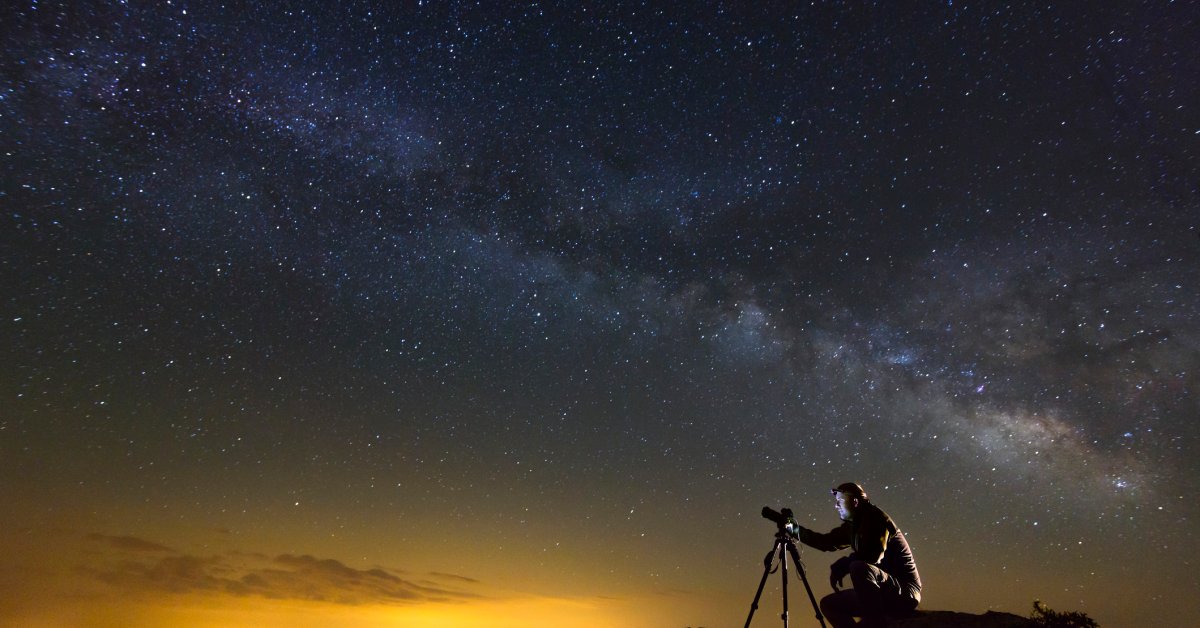Human beings ought to be pretty good at stargazing by now, given that we’ve been doing it since we first emerged on the savannah. What was once a naked-eye exercise has become a high tech business of observing the skies with personal telescopes, university telescopes, radio telescopes, giant observatories, and space-based telescopes—not to mention cameras and other image processing equipment to capture and record what we see. The vast majority of stargazers are amateurs and hobbyists, but that doesn’t mean we can’t learn from the professionals—picking up tips from people who make their living studying the cosmos.
With a suite of celestial entertainment lined up this month—including the full moon known as the Sturgeon Moon on Aug. 8 and 9; a “planet parade, with six planets aligning in the sky from Aug. 10 through the end of the month; and the Perseid meteor shower peaking Aug. 12 and 13—here’s what you need to know to make the most of your time studying the skies.
Prepare your eyes
Night vision and day vision are two different things. Your eyes do a remarkably good job of seeing in low-light conditions, thanks in part to what’s known as rhodopsin, a light-sensitive protein found in the retina of the eye—specifically in the rod cells, which are responsible for our ability to see at night. The familiar experience of adjusting to the dark—with your vision steadily improving the longer you’re in low-light conditions—is the result of rhodopsin building up in the retina. Even a little extraneous light, however, can interfere with this process.
“Rhodopsin gets destroyed by light,” says astronomer Taylor Kutra, a post-doctoral fellow at the Lowell Observatory in Flagstaff, Arizona. “Every time you want to go stargazing you have to sit outside for 30 minutes [in advance] so your eyes can adapt.” That means no looking at your phone or your smartwatch either.
That lights-out rule doesn’t mean you have to go stumbling around in the dark. Red light does not interfere with rhodopsin, and while red flashlights are not commonly available, there are easy hacks to transform the color of an ordinary one. “I have a roll of brake light tape that you can just get from a hardware store,” says Kutra. “You can use it to convert any flashlight into a red flashlight. Another thing I see people do is use red dry erase markers, especially if you have a little flashlight with a plastic cover.”
Get out of town
All the red flashlights and rhodopsin in the world aren’t going to help you much if you’re doing your stargazing in a city swamped by light pollution. Urban skies afford you a view of only a tiny number of conspicuous cosmic objects—the moon, some planets, a very bright star or two. It’s only when you get out to the countryside that the curtain is raised on the whole of the cosmos—including the summer’s Perseid meteor shower and October’s Draconids and Orionids showers.
“There are maps online that tell you what the level of light pollution is where you are, and where are the smart places to go near you,” says Kutra. “I would probably drive an hour in the least populated direction before I would feel good about the light.”
That’s not to say cities and other light polluted areas close off the sky to you entirely. “I’ve had very successful stargazing parties in downtown Toronto, where the light pollution is insane,” Kutra says. The key is lowering your expectations and making the most of that you’ve got. All by itself the moon can be remarkable. A simple pair of binoculars can reveal a lot of features on the lunar surface, especially if the moon isn’t full, meaning sunlight is hitting it at an angle and casting sharp shadows that throw craters, rilles, and mountains into relief.
Map your sky
You can’t properly stargaze if you don’t know what you’re looking for. A few familiar constellations like Orion and the Big Dipper may leap out at you, but the rest is an undifferentiated spangle of stars and worlds. There is a low-tech way and a high tech way to make sense of it all. The low tech way is known as a planisphere, a two-layer map with a paper or cardboard wheel in front that you can spin to select your location, the direction you’re facing, the year and the time of day. Within an opening on the wheel will be the stars and nebulae and constellations in your field of view.
“If you look up planisphere PDF online you can just print it out. It’s two pages of paper, and then you poke a hole in the middle and you stick like a little thumbtack thing through it, so that you can spin it,“ says Kutra. “Then you lay down, and everything that’s in the window of the planisphere is in the sky above you.”
Higher tech versions of planispheres are available as downloadable apps. They use the camera on the phone to search for and label objects. “It’s like augmented reality,” Kutra says. “I really like using it to look for planets because they move throughout the year.”
Cosmic camera
For a lot of amateur astronomers, a night of stargazing is not complete unless you leave with pictures of the objects you’ve observed. Here too phone apps are available that make it possible to get remarkably sharp images of remarkably distant objects, often by “stacking” photos—taking 10 or 20 images of the same object, then digitally aligning them and averaging them, so that the single image that results is sharper. It’s best to mount your phone on a tripod, since your hands could never hold it steady enough for long enough.
Much of this work is done not just with phones but with so-called smart telescopes, which can both automatically steer to a desired object and then photograph it and stack the images. Some of the formations amateurs can capture include the Horsehead Nebula, in the constellation of Orion, 1,300 light years away; the Lagoon Nebula, a star-forming region 4,000 light years away; and the Ring Nebula, 2,000 light years away, whose distinctive shape and bright colors are formed by a dying star expelling material into space.
Don’t go it alone
Kutra strongly recommends checking out local astronomy clubs, including ones offered by nearby universities. “It’s super worth it,” she says. “The events are free or pretty inexpensive. Not only do you see the object but you get an interpretation of what you’re seeing. It’s not like, ‘This is the Orion Nebula, it’s cool.’ [You learn about] the dispersed emissions and the really hot stars that are forming there.”
Being merely an amateur astronomer is no bar to being an exceedingly smart astronomer—one who not only looks at distant objects but understands them too.








